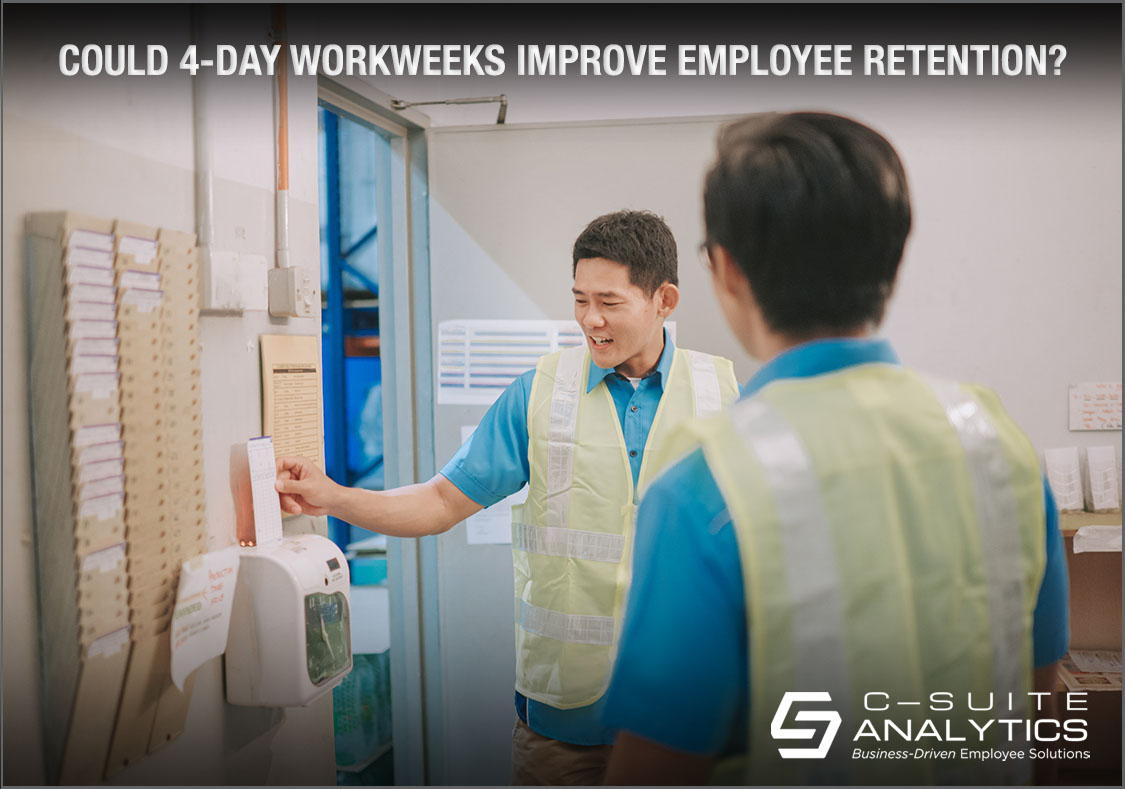Data shows a four-day workweek is popular with employees. On the company side, data suggests work satisfaction and productivity are up, recruiting is easier…and employee turnover is down. And during these days workforce shortages, every company is seeking a recruiting edge. Could this be “it”?
How Does the Cost of Turnover Impact Employee Referrals?

Let’s start here. Employee referrals are four times more likely to be hired, save companies over $7,500 per hire, perform their jobs better than their peer employees…and most importantly for our purposes, stay longer. What’s not to like?
We have developed very specific, most-wouldn’t-think-of-them strategies to increase referrals such that up to half of all of our client companies’ hires come from referrals. And last week one of those client companies connected the dots between referrals and the cost of turnover. And their outcome is brilliant.
Thinking backwards for a minute, consider those times when you debated how much to pay for referrals, maybe slugging it out with your CFO regarding how many hard dollars might fly out the door if you were fortunate enough to get any referrals at all. And I would guess when HR challenges finance over something involving money, HR usually loses. That’s where placing a dollar cost on turnover comes in…and doing so is the very first step we take with our clients.
This client provides a service to its customers delivered by skilled tradespeople, the type of worker who was in high demand even before the current applicant crunch. Nationally, there are a limited number of technicians who can do this work…and there is no easy pathway for hiring interested people and training them. Many earn greater than $100,000 per year and can find jobs with other companies in an hour. Our client has over 100 locations across the U.S. and each location is vulnerable to technicians leaving on any given day.
“Leaving” is where the cost of turnover comes in. This executive team totally buys into that losing one technician for a month results in lost revenue greater than $60,000. And sometimes these jobs stay open for longer than one month. So if you knew this same type of data for your company, would you be sparring with finance over whether to pay $500 or $1,000 for each referral? Probably not.
So our client company made fast policy decisions to fill jobs quickly with employee referrals. For example…
- The referring employee will earn $1 dollar per hour extra for one full year, resulting in a total bump of $2,000 to $3,000 depending on overtime.
- The payout begins when the new hire joins and the only “stay” requirement is the referring employee must stay the full year to receive the continuously-paid bonus.
So this means if I refer someone who gets hired, I just earned a large chunk of cash regardless of how long my referred employee stays…because this client company smartly said it’s the company’s job to decide if the candidate will stay and not the job of the referring employee.
But then comes the extraordinary policy part. This is a policy feature I’ve suggested to scores of clients who saw this idea as too radical…but this client said “absolutely”. When any technician refers five new hires…who must only get hired with no “stay” requirement…that technician gets double payouts for any future referrals. So instead of earning one extra dollar an hour for a year, any employee who refers five technicians who get hired would now earn two. And these referring employees have the potential to continually “recruit” new hires and consequently keep increasing their pay…with no limits.
Bold maybe? A better word is “smart”. Imagine a competitor CEO telling her board of directors, “We lose $60,000 per month when a technician job is open so we’ve initiated an employee referral program where we will pay any technician who refers a new hire a full $500 for each referral”. Not so smart…but common among most companies who don’t connect their referral payout amount to their cost of turnover data.
The key point is the top team has determined the cost of turnover and realizes paying up to $6,000 to fill those jobs is a win/win, and actually a bigger win for the company. And their cost analysis beats back any objection that these represent “soft costs”. Real revenue is flying out their one-hundred-plus doors.
Why is our first step with new clients that we place a dollar value on turnover? Because it’s the ice-cold-bucket-of-water dumped on their executive teams’ heads, the wake-up call that turnover is likely their second or third greatest overall expense. Finance traditionally has no interest in turnover because they see it as HR’s job, all while finance is trying to find coins in the couch to cut costs. And HR makes their top team’s understanding worse by disclosing turnover “benchmarks” which only stifle corrective actions. Compare these two scenarios:
Scenario #1:
HR: Our turnover is 28% and the benchmark is 30%.
CEO: Great work, HR!
Scenario #2:
HR: Our turnover is 28% and it’s costing us $3.4 MM per year.
CEO: We have to fix this!!!
Costing turnover is the genesis, the beginning for gaining vigorous support from your c-suite to then establish retention goals for leaders, implement Stay Interviews, and all other solutions that are part of Finnegan’s Arrow®.
Want to calculate your cost of turnover? You can do so for free here by using our proprietary turnover calculator.
Our Comprehensive Turnover Solution is designed to get results for companies like yours by cutting turnover 30% and more. Write me or connect with me if you want to learn more…DFinnegan@C-SuiteAnalytics.com.



